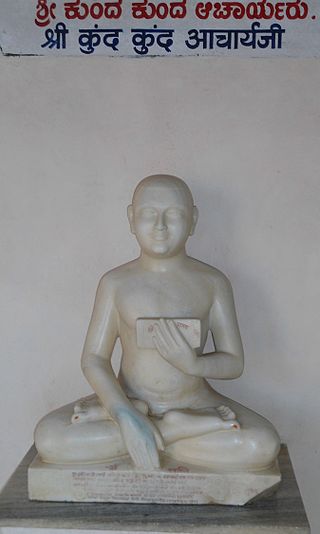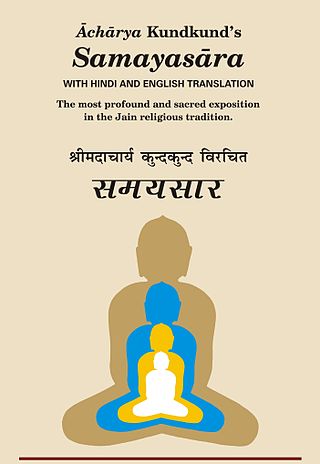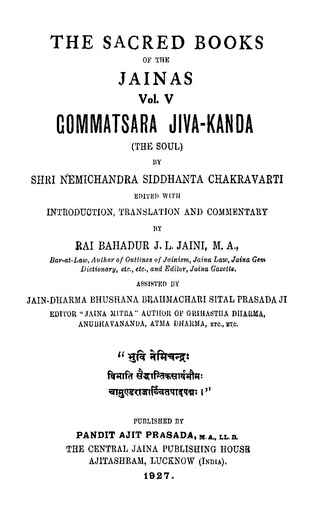Jainism, also known as Jain Dharma, is an Indian religion. Jainism traces its spiritual ideas and history through the succession of twenty-four tirthankars, with the first in the current time cycle being Rishabhadeva, whom the tradition holds to have lived millions of years ago, the twenty-third tirthankara Parshvanatha, whom historians date to the 9th century BCE, and the twenty-fourth tirthankara Mahavira, around 600 BCE. Jainism is considered to be an eternal dharma with the tirthankaras guiding every time cycle of the cosmology. The three main pillars of Jainism are ahiṃsā (non-violence), anekāntavāda (non-absolutism), and aparigraha (asceticism).

Mahavira, also known as Vardhamana, was the 24th tirthankara of Jainism. He was the spiritual successor of the 23rd tirthankara Parshvanatha. Mahavira was born in the early part of the 6th century BCE into a royal Kshatriya Jain family in ancient India. His mother's name was Trishala and his father's name was Siddhartha. They were lay devotees of Parshvanatha. Mahavira abandoned all worldly possessions at the age of about 30 and left home in pursuit of spiritual awakening, becoming an ascetic. Mahavira practiced intense meditation and severe austerities for twelve and a half years, after which he attained Kevala Jnana (omniscience). He preached for 30 years and attained Moksha (liberation) in the 6th century BCE, although the year varies by sect.

Mahavir Janma Kalyanak is one of the most important religious festivals in Jainism. It celebrates the birth of Lord Mahavir, the twenty-fourth and last Tirthankara of present Avasarpiṇī. On the Gregorian calendar, the holiday occurs either in March or April.

Acharya Virasena, also known as Veerasena, was a Digambara monk and belonged to the lineage of Acharya Kundakunda. He was an Indian mathematician and Jain philosopher and scholar. He was also known as a famous orator and an accomplished poet. His most reputed work is the Jain treatise Dhavala. The late Dr. Hiralal Jain places the completion of this treatise in 816 AD.

Jinasena was a monk and scholar in the Digambara tradition of Jainism. He was patronized by the Rashtrakuta king Amoghavarsha I. He was the author of Adipurana and Mahapurana.

Kundakunda was a Digambara Jain monk and philosopher, who likely lived in the 2nd CE century CE or later.

Trishala, also known as Videhadatta, Priyakarini, or Trishala Mata, was the mother of Mahavira, the 24th Tirthankara of Jainism, and wife of the Jain monarch, Siddhartha of Kundagrama, of present-day Bihar. She finds mention in the Jain texts.

Sambhavanatha was the third Jain tirthankara of the present age (Avasarpini). Sambhavanatha was born to King Jitari and Queen Susena at Sravasti. His birth date was the fourteenth day of the Margshrsha shukla month of the Indian calendar. Like all arihant, Sambhavanatha at the end of his life destroyed all associated karmas and attained moksha (liberation).

Mahapurana (महापुराण) or Trishashthilkshana Mahapurana is a major Jain text composed largely by Acharya Jinasena during the rule of Rashtrakuta ruler Amoghavarsha and completed by his pupil Gunabhadra in the 9th century CE. Mahapurana consists of two parts. The first part is Ādi purāṇa written by Acharya Jinasena in Sanskrit. The second part is Uttarapurana which is the section composed by Gunabhadra in Apabhraṃśa.

Samayasāra is a famous Jain text composed by Acharya Kundakunda in 439 verses. Its ten chapters discuss the nature of Jīva, its attachment to Karma and Moksha (liberation). Samayasāra expounds the Jain concepts like Karma, Asrava, Bandha (Bondage), Samvara (stoppage), Nirjara (shedding) and Moksha.

Sanskrit moksha or Prakrit mokkha refers to the liberation or salvation of a soul from saṃsāra, the cycle of birth and death. It is a blissful state of existence of a soul, attained after the destruction of all karmic bonds. A liberated soul is said to have attained its true and pristine nature of infinite bliss, infinite knowledge and infinite perception. Such a soul is called siddha and is revered in Jainism.
Mulachara is a Jain text composed by Acharya Vattakera of the Digambara tradition, around 150 CE. Mulachara discusses anagara-dharma – the conduct of a Digambara monk. It consists twelve chapters and 1,243 verses on. It is also called Digambara Acharanga.
Jain literature refers to the literature of the Jain religion. It is a vast and ancient literary tradition, which was initially transmitted orally. The oldest surviving material is contained in the canonical Jain Agamas, which are written in Ardhamagadhi, a Prakrit language. Various commentaries were written on these canonical texts by later Jain monks. Later works were also written in other languages, like Sanskrit and Maharashtri Prakrit.
Tiloya Panatti or Trilokaprajnapati is one of the earlier Prakrit texts on Jain cosmology composed by Acharya Yativrshabha.
Jīva or Ātman is a philosophical term used within Jainism to identify the soul. As per Jain cosmology, jīva or soul is the principle of sentience and is one of the tattvas or one of the fundamental substances forming part of the universe. The Jain metaphysics, states Jagmanderlal Jaini, divides the universe into two independent, everlasting, co-existing and uncreated categories called the jiva (soul) and the ajiva. This basic premise of Jainism makes it a dualistic philosophy. The jiva, according to Jainism, is an essential part of how the process of karma, rebirth and the process of liberation from rebirth works.
According to the Jain cosmology, the śalākapuruṣa "illustrious or worthy persons" are 63 illustrious beings who appear during each half-time cycle. They are also known as the triṣaṣṭiśalākāpuruṣa. The Jain universal or legendary history is a compilation of the deeds of these illustrious persons. Their life stories are said to be most inspiring.

Kundalpur is a village in Nalanda district in the Indian state of Bihar. It is located about 2.5 kilometres from ancient Nalanda Mahavihara, 11 kilometres southwest of Bihar Sharif, and 80 kilometres southeast of Patna.

Pravachanasara, is a text composed by Jain monk, Kundakunda, in the second century CE or later. The title means "Essence of the Doctrine" or "Essence of the Scripture", and it largely deals with the correct ascetic and spiritual behavior based on his dualism premise. Kundakunda provides a rationale for nudity among Digambara monks in this text, stating that the duality of self and of others means "neither I belong to others, nor others belong to me, therefore nothing is mine and the ideal way for a monk to live is the way he was born". The text is written in Prakrit language, and it consists of three chapters and 275 verses.

Gommatsāra is one of the most important Jain texts authored by Acharya Nemichandra Siddhanta Chakravarti.

The sanskrit word Deva has multiple meanings in Jainism. In many places the word has been used to refer to the Tirthankaras. But in common usage it is used to refer to the heavenly beings. These beings are born instantaneously in special beds without any parents just like hell beings (naraki). According to Jain texts, clairvoyance based on birth is possessed by the celestial beings.
















